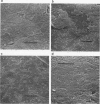Abstract
Survival and growth of Legionella pneumophila in both biofilm and planktonic phases were determined with a two-stage model system. The model used filter-sterilized tap water as the sole source of nutrient to culture a naturally occurring mixed population of microorganisms including virulent L. pneumophila. At 20 degrees C, L. pneumophila accounted for a low proportion of biofilm flora on polybutylene and chlorinated polyvinyl chloride, but was absent from copper surfaces. The pathogen was most abundant on biofilms on plastics at 40 degrees C, where it accounted for up to 50% of the total biofilm flora. Copper surfaces were inhibitory to total biofouling and included only low numbers of L. pneumophila organisms. The pathogen was able to survive in biofilms on the surface of the plastic materials at 50 degrees C, but was absent from the copper surfaces at the same temperature. L. pneumophila could not be detected in the model system at 60 degrees C. In the presence of copper surfaces, biofilms forming on adjacent control glass surfaces were found to incorporate copper ions which subsequently inhibited colonization of their surfaces. This work suggests that the use of copper tubing in water systems may help to limit the colonization of water systems by L. pneumophila.
Full text
PDF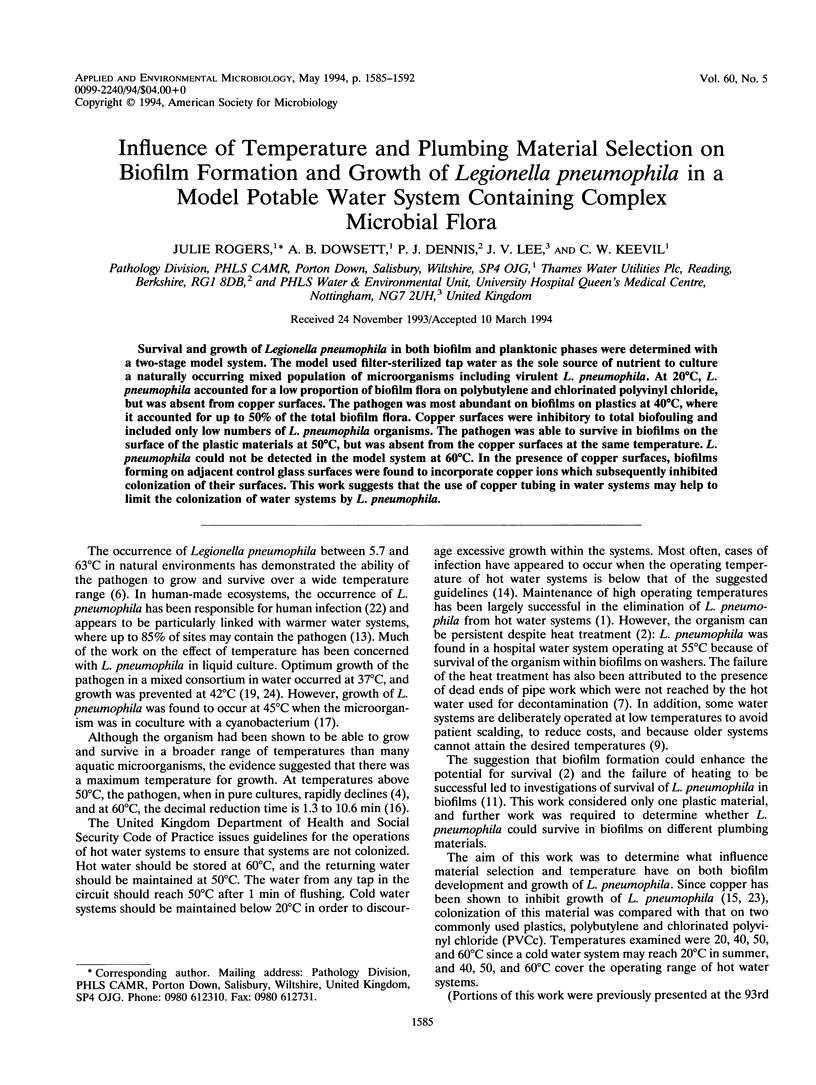
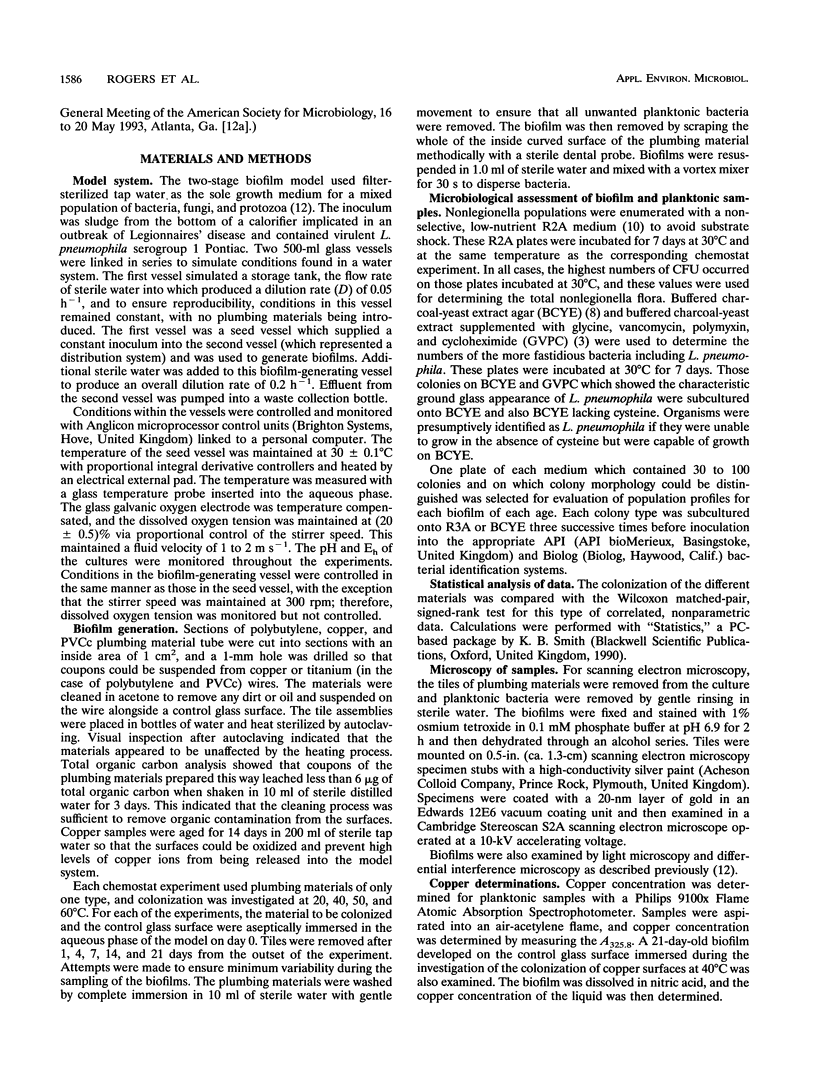
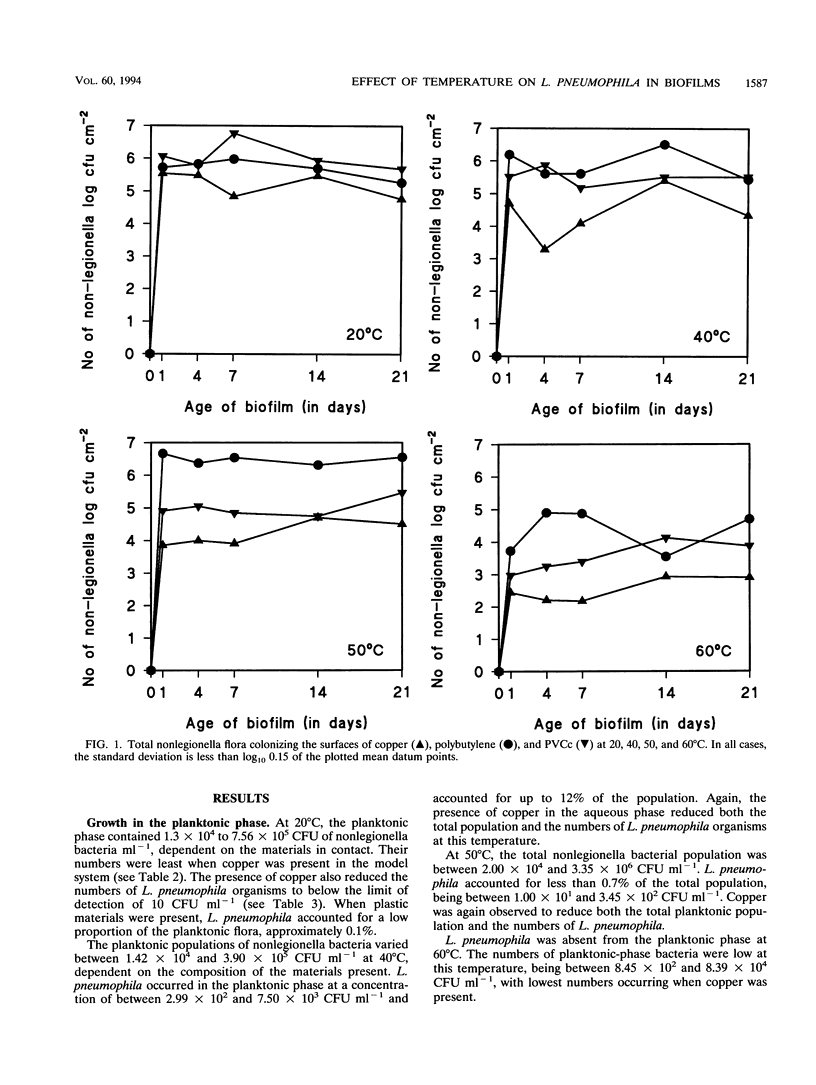
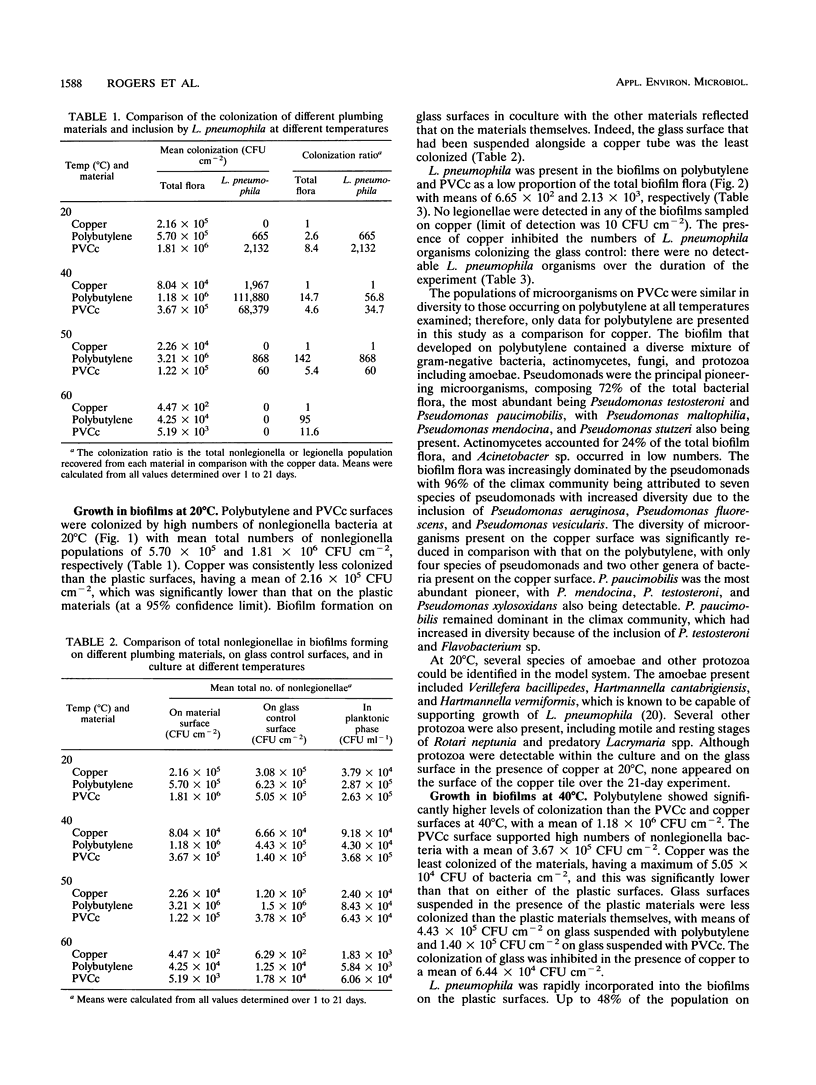
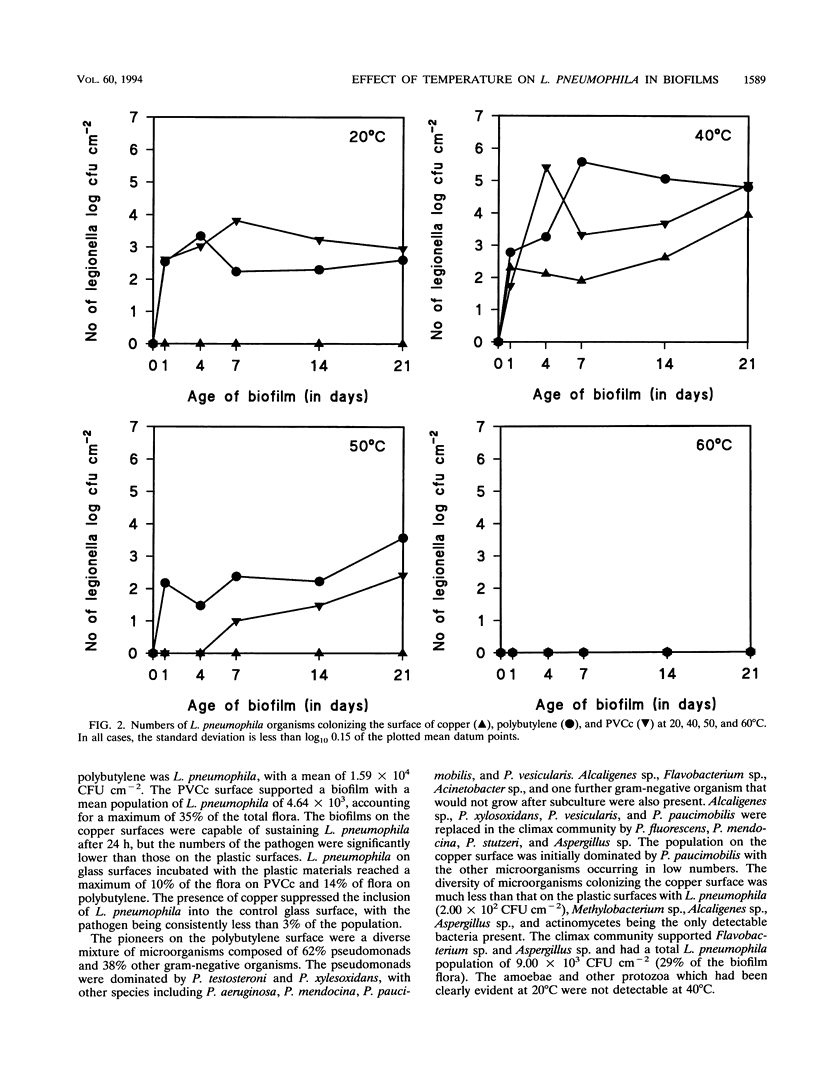
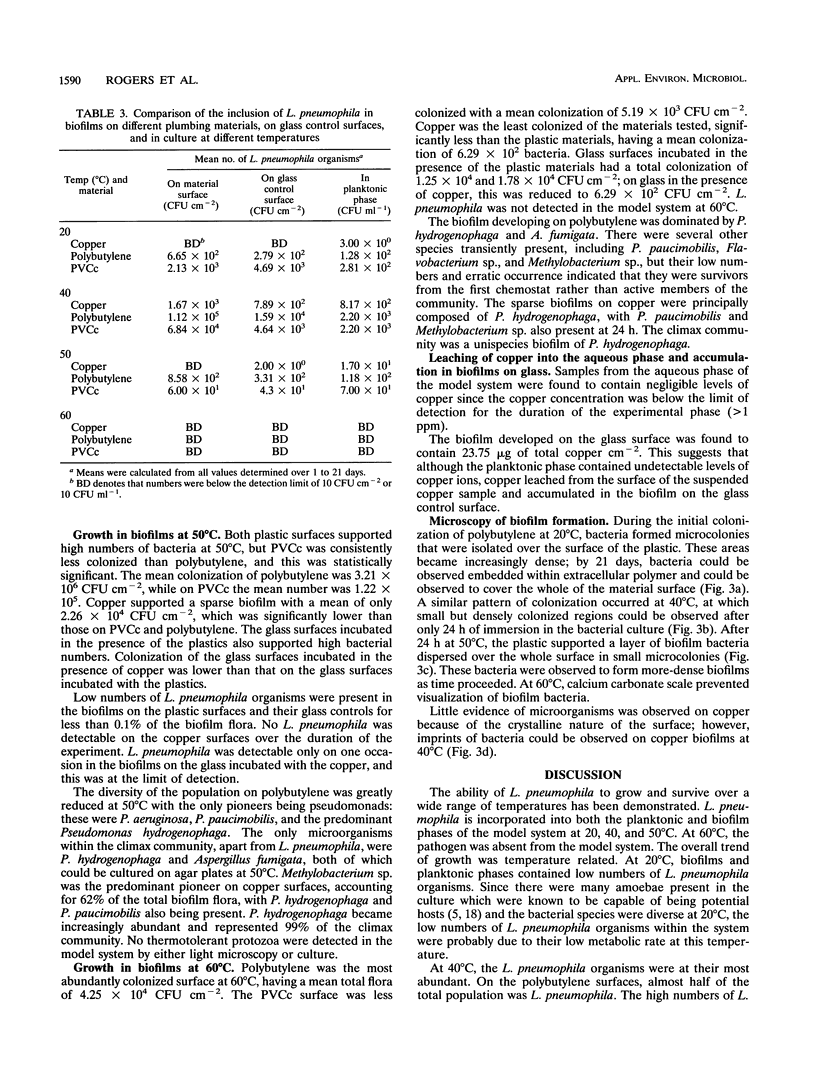
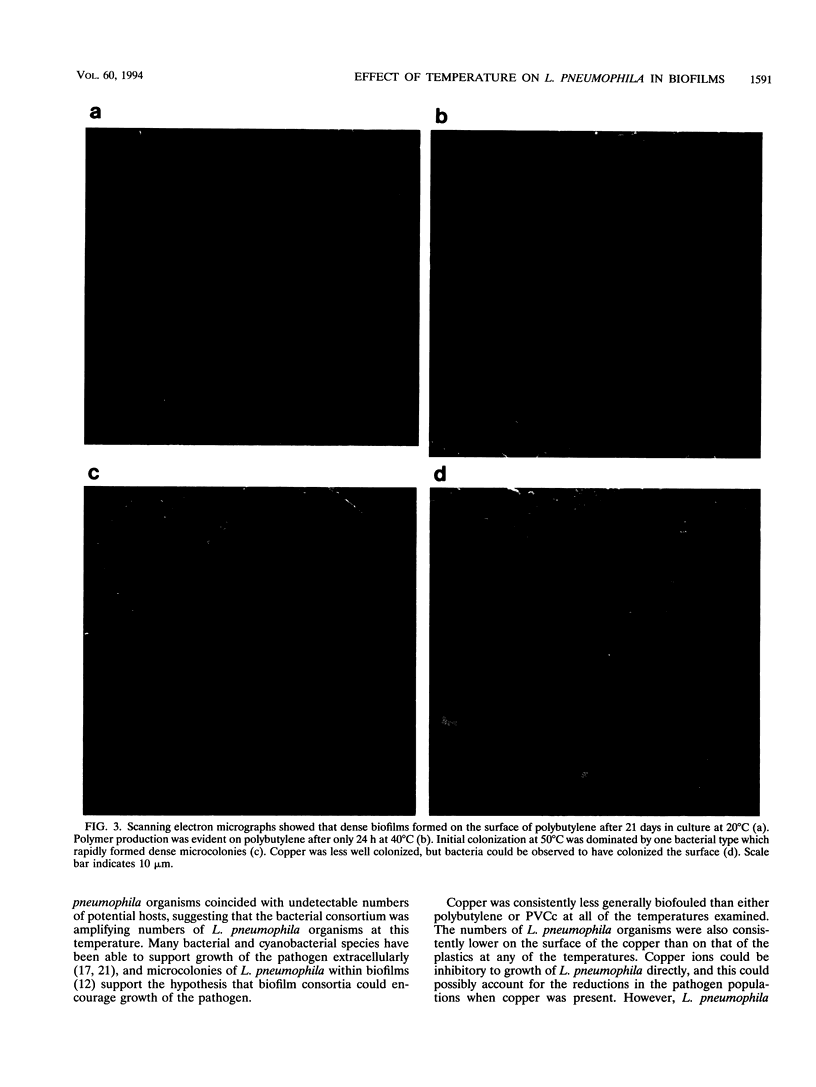
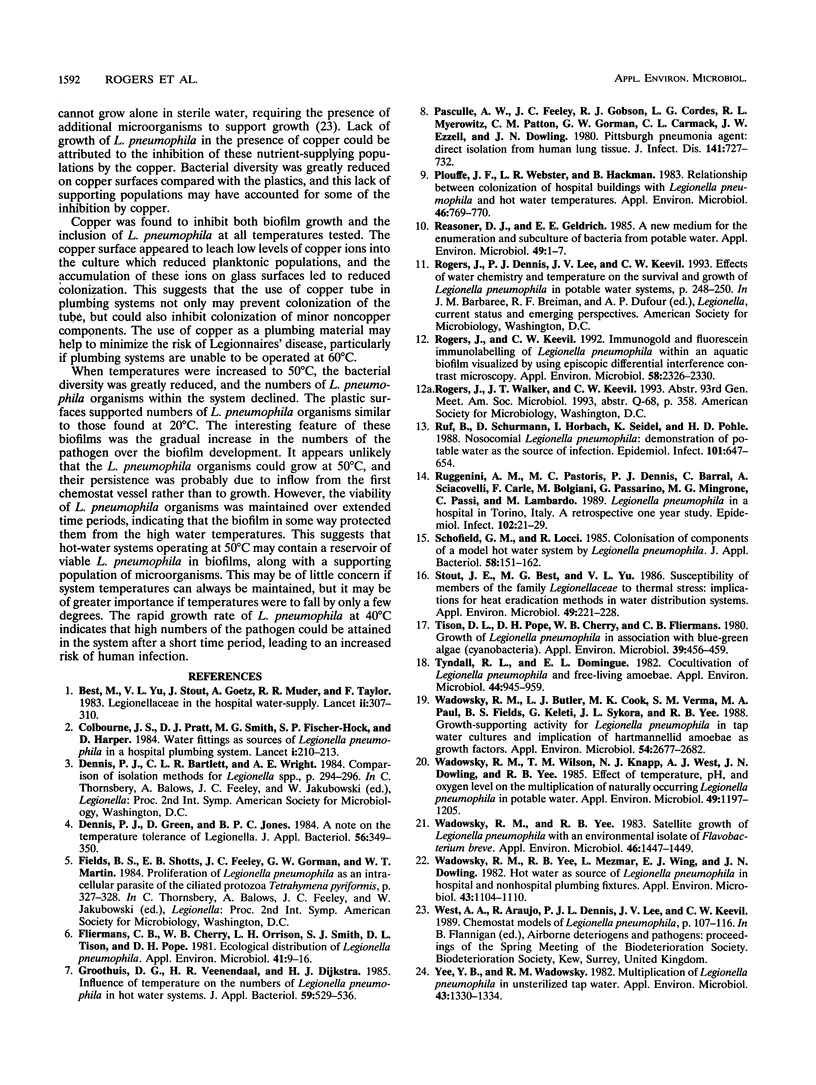
Images in this article
Selected References
These references are in PubMed. This may not be the complete list of references from this article.
- Best M., Yu V. L., Stout J., Goetz A., Muder R. R., Taylor F. Legionellaceae in the hospital water-supply. Epidemiological link with disease and evaluation of a method for control of nosocomial legionnaires' disease and Pittsburgh pneumonia. Lancet. 1983 Aug 6;2(8345):307–310. doi: 10.1016/s0140-6736(83)90290-8. [DOI] [PubMed] [Google Scholar]
- Colbourne J. S., Pratt D. J., Smith M. G., Fisher-Hoch S. P., Harper D. Water fittings as sources of Legionella pneumophila in a hospital plumbing system. Lancet. 1984 Jan 28;1(8370):210–213. doi: 10.1016/s0140-6736(84)92126-3. [DOI] [PubMed] [Google Scholar]
- Dennis P. J., Green D., Jones B. P. A note on the temperature tolerance of Legionella. J Appl Bacteriol. 1984 Apr;56(2):349–350. doi: 10.1111/j.1365-2672.1984.tb01359.x. [DOI] [PubMed] [Google Scholar]
- Fliermans C. B., Cherry W. B., Orrison L. H., Smith S. J., Tison D. L., Pope D. H. Ecological distribution of Legionella pneumophila. Appl Environ Microbiol. 1981 Jan;41(1):9–16. doi: 10.1128/aem.41.1.9-16.1981. [DOI] [PMC free article] [PubMed] [Google Scholar]
- Groothuis D. G., Veenendaal H. R., Dijkstra H. L. Influence of temperature on the number of Legionella pneumophila in hot water systems. J Appl Bacteriol. 1985 Dec;59(6):529–536. doi: 10.1111/j.1365-2672.1985.tb03356.x. [DOI] [PubMed] [Google Scholar]
- Moiraghi Ruggenini A., Castellani Pastoris M., Dennis P. J., Barral C., Sciacovelli A., Carle F., Bolgiani M., Passarino G., Mingrone M. G., Passi C. Legionella pneumophila in a hospital in Torino, Italy. A retrospective one-year study. Epidemiol Infect. 1989 Feb;102(1):21–29. doi: 10.1017/s0950268800029642. [DOI] [PMC free article] [PubMed] [Google Scholar]
- Pasculle A. W., Feeley J. C., Gibson R. J., Cordes L. G., Myerowitz R. L., Patton C. M., Gorman G. W., Carmack C. L., Ezzell J. W., Dowling J. N. Pittsburgh pneumonia agent: direct isolation from human lung tissue. J Infect Dis. 1980 Jun;141(6):727–732. doi: 10.1093/infdis/141.6.727. [DOI] [PubMed] [Google Scholar]
- Plouffe J. F., Webster L. R., Hackman B. Relationship between colonization of hospital building with Legionella pneumophila and hot water temperatures. Appl Environ Microbiol. 1983 Sep;46(3):769–770. doi: 10.1128/aem.46.3.769-770.1983. [DOI] [PMC free article] [PubMed] [Google Scholar]
- Reasoner D. J., Geldreich E. E. A new medium for the enumeration and subculture of bacteria from potable water. Appl Environ Microbiol. 1985 Jan;49(1):1–7. doi: 10.1128/aem.49.1.1-7.1985. [DOI] [PMC free article] [PubMed] [Google Scholar]
- Rogers J., Keevil C. W. Immunogold and fluorescein immunolabelling of Legionella pneumophila within an aquatic biofilm visualized by using episcopic differential interference contrast microscopy. Appl Environ Microbiol. 1992 Jul;58(7):2326–2330. doi: 10.1128/aem.58.7.2326-2330.1992. [DOI] [PMC free article] [PubMed] [Google Scholar]
- Ruf B., Schürmann D., Horbach I., Seidel K., Pohle H. D. Nosocomial legionella pneumonia: demonstration of potable water as the source of infection. Epidemiol Infect. 1988 Dec;101(3):647–654. doi: 10.1017/s0950268800029526. [DOI] [PMC free article] [PubMed] [Google Scholar]
- Schofield G. M., Locci R. Colonization of components of a model hot water system by Legionella pneumophila. J Appl Bacteriol. 1985 Feb;58(2):151–162. doi: 10.1111/j.1365-2672.1985.tb01442.x. [DOI] [PubMed] [Google Scholar]
- Stout J. E., Yu V. L., Best M. G. Ecology of Legionella pneumophila within water distribution systems. Appl Environ Microbiol. 1985 Jan;49(1):221–228. doi: 10.1128/aem.49.1.221-228.1985. [DOI] [PMC free article] [PubMed] [Google Scholar]
- Tison D. L., Pope D. H., Cherry W. B., Fliermans C. B. Growth of Legionella pneumophila in association with blue-green algae (cyanobacteria). Appl Environ Microbiol. 1980 Feb;39(2):456–459. doi: 10.1128/aem.39.2.456-459.1980. [DOI] [PMC free article] [PubMed] [Google Scholar]
- Tyndall R. L., Domingue E. L. Cocultivation of Legionella pneumophila and free-living amoebae. Appl Environ Microbiol. 1982 Oct;44(4):954–959. doi: 10.1128/aem.44.4.954-959.1982. [DOI] [PMC free article] [PubMed] [Google Scholar]
- Wadowsky R. M., Butler L. J., Cook M. K., Verma S. M., Paul M. A., Fields B. S., Keleti G., Sykora J. L., Yee R. B. Growth-supporting activity for Legionella pneumophila in tap water cultures and implication of hartmannellid amoebae as growth factors. Appl Environ Microbiol. 1988 Nov;54(11):2677–2682. doi: 10.1128/aem.54.11.2677-2682.1988. [DOI] [PMC free article] [PubMed] [Google Scholar]
- Wadowsky R. M., Wolford R., McNamara A. M., Yee R. B. Effect of temperature, pH, and oxygen level on the multiplication of naturally occurring Legionella pneumophila in potable water. Appl Environ Microbiol. 1985 May;49(5):1197–1205. doi: 10.1128/aem.49.5.1197-1205.1985. [DOI] [PMC free article] [PubMed] [Google Scholar]
- Wadowsky R. M., Yee R. B., Mezmar L., Wing E. J., Dowling J. N. Hot water systems as sources of Legionella pneumophila in hospital and nonhospital plumbing fixtures. Appl Environ Microbiol. 1982 May;43(5):1104–1110. doi: 10.1128/aem.43.5.1104-1110.1982. [DOI] [PMC free article] [PubMed] [Google Scholar]
- Wadowsky R. M., Yee R. B. Satellite growth of Legionella pneumophila with an environmental isolate of Flavobacterium breve. Appl Environ Microbiol. 1983 Dec;46(6):1447–1449. doi: 10.1128/aem.46.6.1447-1449.1983. [DOI] [PMC free article] [PubMed] [Google Scholar]
- Yee R. B., Wadowsky R. M. Multiplication of Legionella pneumophila in unsterilized tap water. Appl Environ Microbiol. 1982 Jun;43(6):1330–1334. doi: 10.1128/aem.43.6.1330-1334.1982. [DOI] [PMC free article] [PubMed] [Google Scholar]



